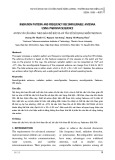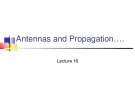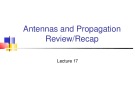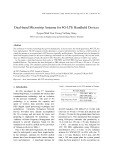
Antenna's radiation pattern
-
This paper proposes a radiation pattern and frequency reconfigurable antenna using four PIN diodes. The antenna structure is based on the Padovan sequence of nine squares on the patch and four ones on the ground. In this way, the antenna's radiation pattern can be recognized at +52° and 27°. Also, the reconfigurable frequency of the proposed antenna can change from 5 GHz to 18.74 GHz. The total antenna size is rather small, which is 44.44 x 35 x 1.52 mm3 . Besides, the antenna can achieve rather high efficiency and a quite good bandwidth at almost operating bands.
 9p
9p  trinhthamhodang1220
trinhthamhodang1220
 21-07-2021
21-07-2021
 9
9
 1
1
 Download
Download
-
The following will be discussed in this chapter: Dipole antenna, antenna gain, antenna length, radiation mechanism, radiation pattern, antenna efficiency, beam width, types of antennas, propagation modes, noise categories.
 104p
104p  nanhankhuoctai8
nanhankhuoctai8
 23-06-2020
23-06-2020
 11
11
 1
1
 Download
Download
-
The following will be discussed in this chapter: Antenna functions, isotropic antenna, radiation pattern, parabolic reflective antenna, antenna gain, signal loss in satellite communication, noise types, refraction, fading, diffraction and scattering, fast and slow fading, flat and selective fading, diversity techniques.
 136p
136p  nanhankhuoctai8
nanhankhuoctai8
 23-06-2020
23-06-2020
 8
8
 0
0
 Download
Download
-
The following will be discussed in this chapter: Radiation pattern, parabolic reflective antenna, antenna gain, signal loss in satellite communication, noise types, refraction, fading, diffraction and scattering, fast and slow fading, flat and selective fading, diversity techniques.
 76p
76p  nanhankhuoctai8
nanhankhuoctai8
 23-06-2020
23-06-2020
 17
17
 1
1
 Download
Download
-
In this paper, a novel antenna array at 5GHz is presented with a low sidelobe level and wide impedance bandwidth for indoor positioning applications . The antenna array has the size of 450 ×57×0.8 mm3 with the high gain of 14.5dBi and the low SLL of -18 dB at 5GHz. The sesier feed using Unequal Split T-Junction is proposed with the Chebyshev-amplitude distribution to improve SLL. Besides the 1800 phase and amplitude distribution, by deploying driven elements above each single antenna element, the radiation pattern and the gain of the antenna aray are significantly improved.
 11p
11p  12120609
12120609
 01-06-2020
01-06-2020
 18
18
 1
1
 Download
Download
-
This paper will propound an antenna covering the range of frequencies from 1.53 GHz to 2.53 GHz that includes 1.575 GHz, 1.8 GHz, 1.9 GHz ,and 2.1 GHz. The developed quasi-Yagi antenna has a simple-low profile and achieves a bandwidth of 48%, a front- to- back ratio of 19 dB, a gain of 6dBi, and an efficiency of better than 78% at 2.1GHz. In this paper, the study on effects of parameters of the antenna is also investigated to achieve optimal model.
 10p
10p  minhxaminhyeu3
minhxaminhyeu3
 25-06-2019
25-06-2019
 19
19
 1
1
 Download
Download
-
In this paper, a dual-band antenna that works at 1780 MHz and 2610 MHz has been proposed for 4G-LTE handheld devices. The antenna has been designed on FR4 substrate with sizes of 20 mm × 50 mm × 1.2 mm to fit the mobile casing. The simulation and measurement results of both return loss and radiation patterns have also been presented. Very good agreement between simulated ans measured data has been obtained.
 5p
5p  vixyliton2711
vixyliton2711
 17-04-2019
17-04-2019
 26
26
 3
3
 Download
Download
-
A planar antenna with a broadband feeding structure is presented and analyzed for ultrawideband applications. The proposed antenna consists of a suspended radiator fed by an n-shape microstrip feed. Study shows that this antenna achieves an impedance bandwidth from 3.1–5.1 GHz (48%) for a reflection of coefficient and an average gain of 7.7 dBi. Stable boresight radiation patterns are achieved across the entire operating frequency band, by suppressing the high order mode resonances. This design exhibits good mechanical tolerance and manufacturability....
 4p
4p  vanminhphuong
vanminhphuong
 18-01-2011
18-01-2011
 93
93
 6
6
 Download
Download
-
So, given PT and G it is possible to calculate the power density at any point in the far ®eld that lies in the direction of maximum radiation. A knowledge of the radiation pattern is necessary to determine the power density at other points. The power gain is unity for an isotropic antenna, i.e. one which radiates uniformly in all directions, and an alternative de®nition of power gain is therefore the ratio of power density, from the speci®ed antenna, at a given distance in the direction of maximum radiation, to the power density at the same point, from an isotropic...
 20p
20p  khinhkha
khinhkha
 20-07-2010
20-07-2010
 60
60
 8
8
 Download
Download
-
The electromagnetic power is generated and radiated by antennas. Timevarying current radiates electromagnetic waves (radiated electromagnetic fields). Radiation pattern, beam width, directivity, and other major characteristics can be studied using Maxwell’s equations, see Section 2.2. We use the vectors of the electric field intensity E, electric flux density D, magnetic field intensity H, and magnetic flux density B. The constitutive equations are D = εE and B = µH where ε is the permittivity; µ is the permiability. It was shown in Section 2.
 36p
36p  longmontran
longmontran
 14-01-2010
14-01-2010
 112
112
 23
23
 Download
Download
-
The radiation pattern is a graphical depiction of the relative field strength transmitted from or received by the antenna. Antenna radiation patterns are taken at one frequency, one polarization, and one plane cut.
 9p
9p  nguyen4
nguyen4
 18-11-2009
18-11-2009
 79
79
 6
6
 Download
Download
-
The radiation patterns of the antennas presented in the previous section are for antenna geometries most commonly used.
 4p
4p  hoang1
hoang1
 02-11-2009
02-11-2009
 74
74
 7
7
 Download
Download





















